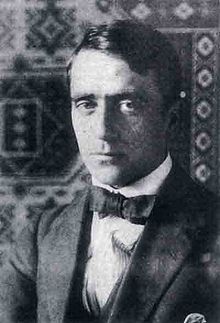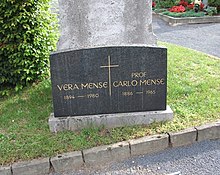Carlo Mense
Carlo Mense (born May 13, 1886 in Rheine , Westphalia , † August 11, 1965 in Königswinter ) was a German painter of Rhenish Expressionism and New Objectivity . He was a professor at the State Academy of Arts and Crafts in Wroclaw .
Life
As the second youngest of seven children, Carlo Mense began a commercial apprenticeship at his father's request, which he broke off to devote himself to painting.
After completing his military service, he studied on the advice of August Macke from 1906 to 1908 at the Düsseldorf Art Academy with Peter Janssen . A trip with his brother Rudolf took him to Ascona on Monte Verità , where he came into contact with the reform movement that had a decisive influence on him. In 1908 Mense continued studying with Lovis Corinth in Berlin, but soon left the city to continue his studies in Weimar and Munich .
In 1910 the young painter returned to the Rhineland and joined the newly founded Cölner Secession and in 1911 the Gereonsklub , and under the pseudonym "Otto Marto" he became a member of the workers at House Nyland . As early as 1912 his works were represented at the legendary Sonderbund exhibition in Cologne, as well as at the exhibition The Rhenish Expressionists in Bonn , initiated by August Macke in 1913 . He got to know Herwarth Walden , for whose expressionist magazines Die Aktion and Der Sturm he designed graphic works and title pages.
With his good friend Heinrich M. Davringhausen he traveled back to Ascona in 1914. During the First World War Mense was a soldier in Belgium, Poland and Russia.
Mense was one of the founders of the Society for Art , which published the magazine Der Strom . In 1918 he joined the association Das Junge Rheinland and the Novembergruppe . First solo exhibitions in the Galerie Neue Kunst von Hans Goltz in Munich and in the Art Salon Goldschmidt in Frankfurt followed.
After his marriage to Vera Baske in 1919, Mense often stayed in Munich, where he had good contacts with Paul Klee and the Schwabing art scene. Oskar Kokoschka , Georg Schrimpf , Alexander Kanoldt and Richard Seewald were among his close circle of friends.
Carlo Mense traveled to Italy for the first time in 1920, where he stayed in Positano for long periods of time until 1925 . Richard Seewald and other painters followed there.
In 1925 he took part in the exhibition Neue Sachlichkeit in the Kunsthalle Mannheim. In the same year the State Academy for Arts and Crafts in Breslau appointed Mense as a professor, where he became friends with Oskar Schlemmer and Oskar Moll . In 1932 the Breslau Academy was closed and the painter lost his job. The award of the Rome Prize in 1933 by the Deutsche Akademie Rome Villa Massimo helped him to obtain a scholarship at the Villa Massimo.
In the course of the confiscation of works that were defamed as degenerate art , the National Socialists confiscated 34 paintings by the artist from public collections in 1937 and destroyed them.
After participating as a frontline officer in World War II , Carlo Mense lived again at his parents' home in Bad Honnef from the end of 1944 after bombing raids destroyed his studio in Cologne. On his 70th birthday, a solo exhibition took place in Königswinter in 1956. On May 9, 1961, he was honored with the Federal Cross of Merit, 1st class. His grave is in the old cemetery in Bad Honnef.
literature
- Aurel Bongers, Joachim Heusinger von Waldegg , Dierk Stemmler (eds.): The Rhenish Expressionists - August Macke and his painter friends. Bonn 1984, ISBN 3764703237 .
- Klara Drenker-Nagels: Carlo Mense: His life and work from 1909 to 1939. Cologne 1993, ISBN 3927396575 .
- Klara Drenker-Nagels: Carlo Mense. The flow of life. Association August-Macke-Haus, Bonn 2000 (series of publications by the Association August-Macke-Haus eV Volume 33). ISBN 978-3-9296-0732-1
- Johannes Grave (Ed.): The double face of the big city. Carlo Mense, Josef Winckler and the workmen at House Nyland. Catalog for the exhibition in the Bentlage Monastery, in the August Macke House in Bonn and in the Westphalian State Museum in Münster. Steinfurt 2002, ISBN 3-934427-17-0 .
- Sarah Rothe: “In a happy period”. Carlo Mense in Wroclaw. In: Dagmar Schmengler u. a. (Ed.): Painter. Mentor. Magician. Otto Mueller and his network in Breslau . Heidelberg u. a .: Kehrer 2018. ISBN 978-3-86828-873-5 , pp. 206-212.
Web links
- Literature by and about Carlo Mense in the catalog of the German National Library
- Carlo Mense website
- Jana Magdanz: August 11, 1965 - anniversary of the death of the painter Carlo Mense WDR ZeitZeichen on August 11, 2020 (podcast)
Individual evidence
- ^ Karl Günter Werber : Honnefer walks . 2nd revised edition. Verlag Buchhandlung Werber, Bad Honnef 2002, ISBN 3-8311-2913-4 , p. 101 .
- ↑ Office of the Federal President
- ^ Gerhard J. Bellinger , Brigitte Regulator-Bellinger : Schwabings Ainmillerstraße and its most important residents . 2003, ISBN 3-8330-0747-8 , pp. 287 .
| personal data | |
|---|---|
| SURNAME | Mense, Carlo |
| ALTERNATIVE NAMES | Mense, Carl |
| BRIEF DESCRIPTION | German painter of Rhenish Expressionism and the New Objectivity |
| DATE OF BIRTH | May 13, 1886 |
| PLACE OF BIRTH | Rheine |
| DATE OF DEATH | August 11, 1965 |
| Place of death | Koenigswinter |

